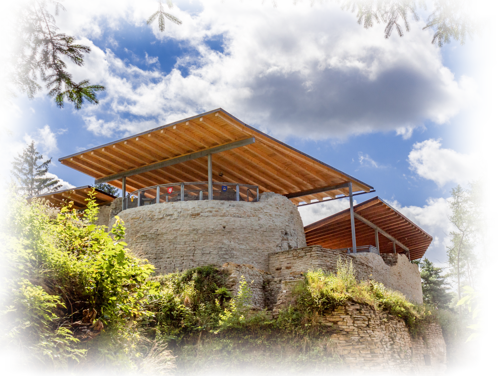

About Vízmburk Castle
Vízmburk castle is located in the northern part of the Czech Republic, near the borders with Poland and Germany.
The name of the Vízmburk Castle first appears in Dalimil's Chronicle
in 1279, where it is mentioned in the form of the predicate of its first owner, Tasa of Vízmburk. He came from a noble family with the coat of arms
of a golden stirrup, which played an important role in the colonization of northeastern Bohemia in the mid-13th century.
In his chronicle, Dalimil describes the battles of the Czech lords against the armies of Otto V. of Brandenburg - he was the guardian of the young King Wenceslas II. Tas gained important positions in the administration
of royal estates in Poland. He was the castle keeper of Krakow
and Sandomierz and later mayor of Kujawy and Pomerania, which at that time belonged to the Czech Kingdom. In 1303, Tas's career reached its peak. He became the chamberlain of the Czech Kingdom. In 1304 he was murdered due to a dispute over property with his neighbor Jan Vlk
of Rtyně.
The next owner of the castle was Tas´s son Jaroš, who inherited both his wealth and his impulsive nature. We learn about his disputes with a local monastery from documents sent to the Pope. Jaros sold his estates
to Milota of Pnětluk around 1309. The next owner of the castle was Arnošt of Hostýn, who exchanged it with the lords of Dubá before 1309. Since then, it was jointly owned by the brothers Hynek Crha, Hajman, Hynek Hlaváč, and Václav of Dubá. We learn about this exchange thanks
to a document from the king Charles IV, who granted it to his bishhop Arnošt of Pardubice.
The last owner of the castle was Jiří of Dubá and Vizmburk in 1420. Jiří was initially a supporter of Hussite teachings, but soon sided with Emperor Sigismund, from whom he received a loan of 15,000 groschen for
an estate in central Bohemia. These included Vildštejn, Chotěboř, Drobovice, and Žleby, where Jiří settled and died in 1451. In the years following the Hussite Wars, the country was ravaged by groups
of scattered Hussite troops, and the castle garrison from Vízmburk, together with garrisons from neighboring castles, raided towns
n neighboring Silesia and Lusatia. Although these raids caused massive damage to the towns of Silesia and Lusatia, thanks to skilful politics, open conflict never broke out. Vízmburk Castle was sold to the Silesians in 1447 and demolished. This marks the end of the castle's medieval history.
Archeological Research 1972-1984
The next chapter in the castle's history began in 1972, when extensive research was launched under the leadership of Dr. Antonín Hejna
from the Archaeological Institute of the Czechoslovak Academy
of Sciences. Before the research began, only the outlines of the castle walls were visible on the wooded slope. During the research, the remains of a Gothic castle, whose stone walls reached a height of up to eight meters in places, were discovered. A large number of archaeological finds were also made, revealing the lives of the castle's last inhabitants, and the castle was called the Pompeii of the Krkonoše Mountains. The last archaeological season took place in 1984.
The Castle´s Architecture
Vízmburk Castle was dominated by a cylindrical tower, known
as a bergfrit, approximately 25 meters high, located in the northwest corner of the castle above the access road. The castle was entered through two gates with drawbridges. After crossing the second bridge, we come to the outer bailey, which is located between the ramparts
and the castle walls and surrounds the entire castle. The gate on the west side led to a paved courtyard measuring 20 x 11 meters.
The southern and southeastern parts of the castle have cellars. In this corner of the castle, there were representative rooms with two halls, vaulted with two fields of cross vaults with magnificent architectural elements. There was also a tiled stove here. In the northeast part of the castle, there were rooms with facilities for the castle kitchen, which is located under the large tower. The west wing of the castle probably served as a farm building. A large number of horseshoes and tools were found here. Near the kitchen, there is a filtration cistern used to store water.
The castle is built of white sandstone. The window frames and some doors were decorated with red sandstone, creating an interesting color contrast.
Association for Vízmburk
The Association of Friends of Vízmburk Castle was founded in 2002. In its early years, the association focused on preserving archaeological finds. Since 2008, it has also been taking care of the entire castle, which it has been leasing from the state since 2012. In the same year, a concept
for roofing the castle was developed. A year later, the association received a special-purpose grant from the LEADER ČR program for roofing
the west wing of the castle. In 2014, construction work began
on reconstruction of the defensive tower. In 2015, construction work continued on the cylindrical tower, followed by repairs to the southern perimeter wall. In the following years, repairs to other parts of the castle continued. In 2020, extensive reconstruction of the castle roof
and conservation of the masonry took place, with a total value of approximately CZK 19 million from the Czech-Polish Interreg V program. In 2021, exhibitions were created and the castle was opened to the public. The association then continued with the self-help restoration of the outer bailey wall and securing the rock against destruction.
The Association for Vízmburk manages tourism, maintains the castle, gradually repairs other parts of the outer castle, and organizes a number of cultural events on the castle grounds, including seminars, publications, performances, and concerts. In 2024, a permanent exhibition of archaeological finds was opened in the building of the Municipal Museum and Gallery in Úpice.
Text by Association for Vízmburk
You can order in our e-shop.
Back













